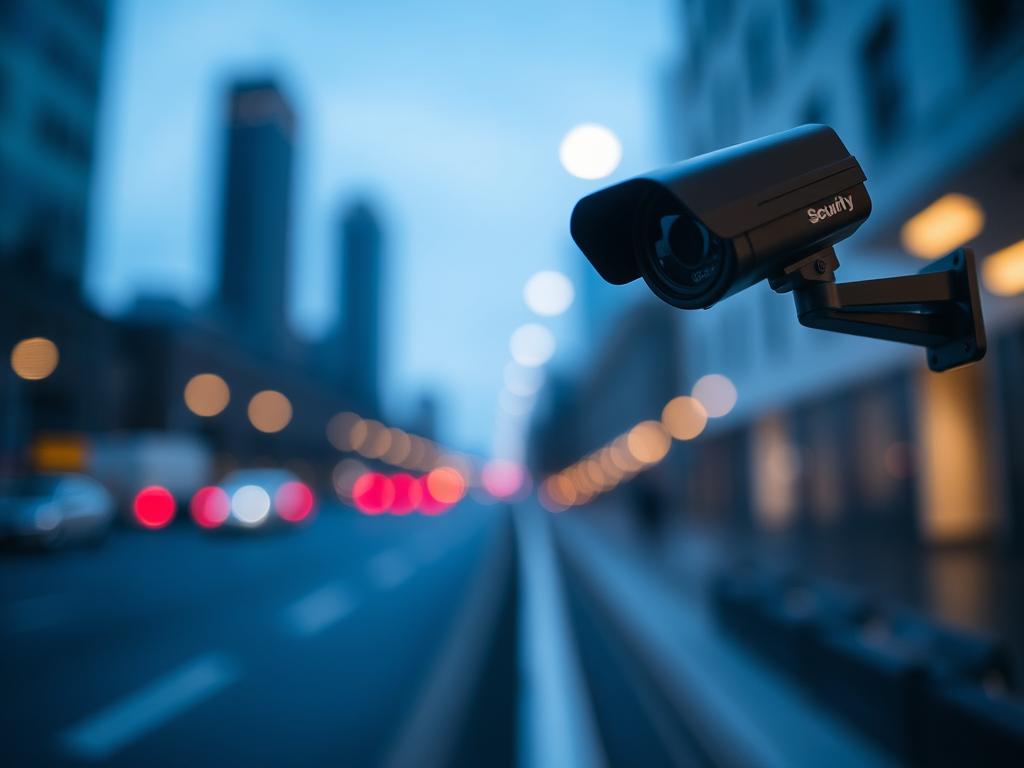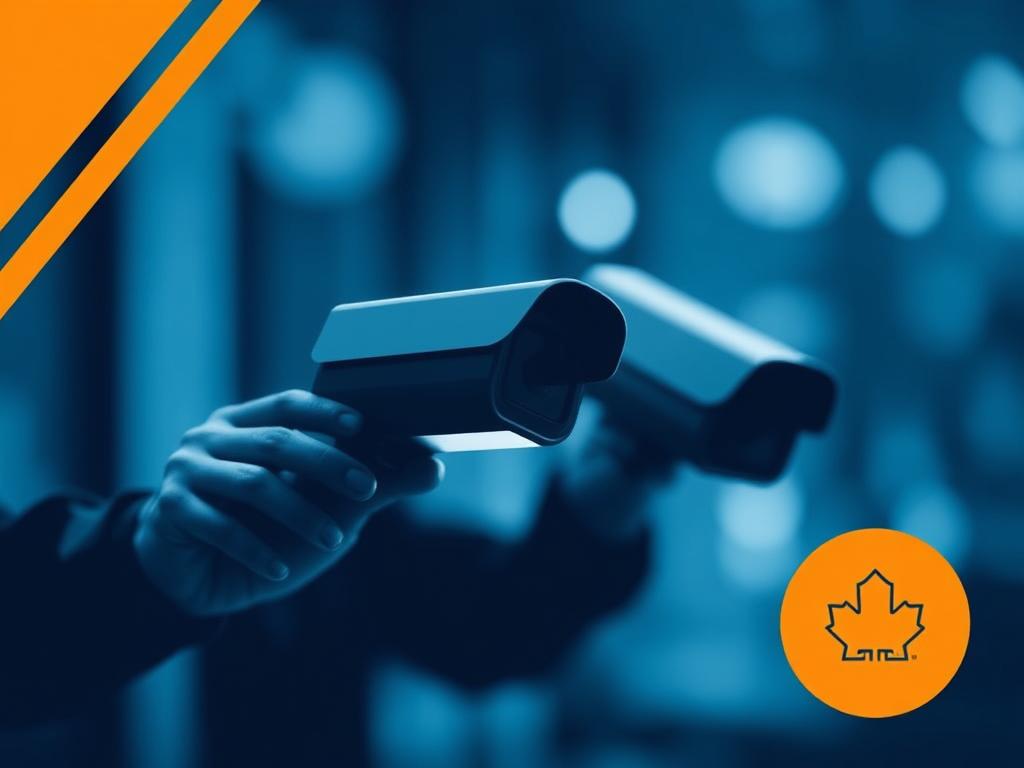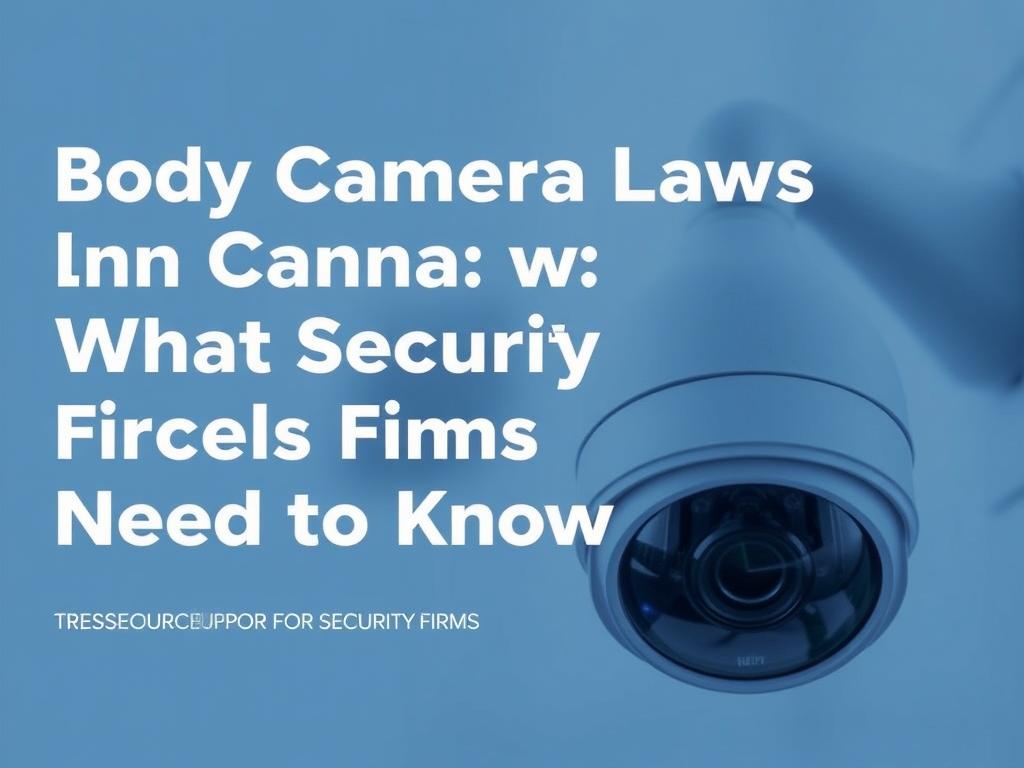In recent years, body cameras have become an essential tool for many security firms across Canada. They provide an unbiased record of interactions between security personnel and the public, which can be crucial in resolving disputes, documenting incidents, and enhancing overall safety practices. However, using body cameras isn’t as straightforward as simply recording everything. There are strict legal frameworks guiding their use, designed to balance public safety and privacy rights. For security firms operating in Canada, understanding body camera laws is not just a best practice — it’s a legal requirement that safeguards both the company and its employees.
Canada’s body camera laws place a heavy focus on privacy, consent, and data protection. With Canada’s diverse legal landscape, businesses must navigate a complex web of federal and provincial regulations. This article provides a comprehensive overview of the key legal points security firms need to keep in mind when deploying body cameras. We will explore the relevant privacy legislation, consent requirements, data management protocols, and practical tips to stay compliant. If you’re a security professional or business owner thinking of incorporating body cameras into your operations, this guide covers everything you need to know.
Understanding Privacy Laws Related to Body Cameras
Privacy is the cornerstone of body camera regulations in Canada. Since body cameras capture video and sometimes audio of individuals, they inevitably collect personal information. The Personal Information Protection and Electronic Documents Act (PIPEDA) is the federal law that governs how private sector organizations collect, use, and disclose personal information during commercial activities. Most provinces have similar legislation with additional or varying provisions.
Security firms need to understand that video footage recorded by body cameras qualifies as personal information under PIPEDA. This means footage must be handled with the same care as any other sensitive client or employee data. Unauthorized use or disclosure of body camera footage can result in legal actions and hefty fines.
Key Provisions of PIPEDA That Affect Body Camera Use
The following table summarizes the main rules under PIPEDA applicable to body cameras:
| Provision | Explanation |
|---|---|
| Consent | Organizations must obtain meaningful consent before collecting personal information, with some exceptions in public safety contexts. |
| Purpose | Personal information must only be collected for identified purposes and used accordingly. |
| Limiting Use and Disclosure | Information can only be used or disclosed for the purpose it was collected unless further consent is obtained. |
| Safeguards | Organizations must protect personal information with security measures appropriate to the sensitivity. |
| Openness and Accountability | Businesses must be transparent about their information practices and appoint someone to oversee compliance. |
Provincial privacy laws such as the Alberta Personal Information Protection Act (PIPA) or British Columbia’s PIPA often echo these rules but may have additional requirements or interpretations. Security firms must be aware of the regional laws where their body cameras will operate.
When and How Can Consent Be Obtained?
Consent is one of the trickiest legal areas when it comes to body camera use. Ideally, security firms should inform individuals that they are being recorded and obtain consent before activating a body camera. However, in many scenarios, such as spontaneous or emergency incidents, obtaining prior consent is not feasible.
Canadian privacy laws recognize this challenge and generally allow for implied consent in public areas or situations where there is a lawful reason to record. However, this does not mean that security firms have a free pass. The principle of reasonableness applies — filming should be limited to what is necessary to fulfill legitimate security purposes.
Types of Consent Relevant to Body Camera Use
- Express Consent: Explicit permission given verbally or in writing before recording.
- Implied Consent: Consent inferred from actions, such as entering a space with clear signage indicating recording is in progress.
- Informed Consent: Individuals understand how their data will be used and stored.
For security firms, it is best practice to combine express and informed consent where possible. For example, by posting signs at entrances or on uniforms informing people that body cameras are in use. This openness helps build trust and minimizes privacy complaints.
Rules About Recording Audio Versus Video Footage
While body cameras record video and may also capture audio, the laws surrounding audio recording are often stricter. In Canada, the Recording of Conversations without Consent is governed by criminal law provisions which differ from video surveillance rules.
Audio Recording Legal Requirements
Recording private conversations without consent is illegal under the Criminal Code of Canada unless an exception applies. For security personnel using body cameras, this means:
- Audio can only be recorded if one of the parties consents (usually the security officer).
- Recording conversations where there is a reasonable expectation of privacy (e.g., private offices, washrooms) is prohibited.
- In public spaces, audio recording may be more permissible but should still be limited to necessary contexts.
Given the legal risks, many security firms opt to disable audio recording on body cameras except in specific, controlled situations. Training staff on when and where audio can be legally recorded is essential.
Data Storage, Access, and Retention Policies
Body camera footage is sensitive data that must be properly stored, accessed, and retained or deleted in compliance with privacy laws. Mishandling footage can lead to breaches of confidentiality and liability.
Canadian privacy regulations state that organizations should keep personal information only as long as necessary for the stated purpose. In the case of body cameras, this usually means deleting footage once any investigations or disputes are resolved unless retention is legally required.
Best Practices for Managing Body Camera Footage
| Practice | Reason |
|---|---|
| Encrypted Storage | Prevents unauthorized access and protects privacy. |
| Access Controls | Limit footage viewing to authorized personnel only. |
| Clear Retention Schedules | Ensures footage is deleted according to policy and legal requirements. |
| Audit Trails | Record who accessed footage and when for accountability. |
Security firms should also develop clear policies on how footage requests are handled, whether from clients, law enforcement, or the public. Transparency in these processes reinforces compliance and trust.
How Does Provincial Legislation Differ Across Canada?
Canada’s federal privacy law, PIPEDA, provides a baseline, but provinces may impose additional rules affecting body camera use in their jurisdictions. Here are examples of significant provisions from key provinces:
- Ontario: The Freedom of Information and Protection of Privacy Act (FIPPA) governs public institutions and applies to some security services. It emphasizes transparency and access rights related to recorded information.
- Alberta: The Personal Information Protection Act (PIPA) requires organizations to notify individuals when their information is collected, including video recordings, and to provide access upon request.
- British Columbia: BC’s PIPA includes similar provisions but stresses limiting the collection of personal information wherever possible.
Security firms must tailor their body camera policies to align with the province where they operate. Consulting legal counsel knowledgeable in local privacy laws is strongly recommended to ensure full compliance.
Implications for Security Firms and Their Staff

Body camera laws impact not only the security firms’ operational policies but also employee training and behavior. Using body cameras incorrectly can expose staff and companies to legal risk and damage reputations.
Training Essentials for Staff on Body Camera Use
- Understanding consent requirements and notifying individuals where possible.
- Knowing when it is appropriate to turn cameras on and off.
- Following protocols for data handling, including footage upload and storage.
- Respecting privacy in sensitive or restricted areas.
- Being aware of the legal consequences of unauthorized recording or misuse of footage.
Regular training ensures that staff not only use body cameras effectively but do so respecting privacy laws and ethical standards. It can also help security firms demonstrate their commitment to responsible practices, which may be a competitive advantage.
Emerging Trends and Future Directions in Body Camera Regulations

As body cameras become more prevalent and technology advances, legislation and industry standards are evolving. Privacy watchdogs and courts continue to refine interpretations of applicable laws.
Some emerging trends include:
- Stricter Data Protection Standards: Increasing focus on encrypted storage, limited retention, and breach notification requirements.
- Enhanced Transparency: More detailed disclosure of how footage is used and shared, including access rights for recorded individuals.
- AI and Facial Recognition Concerns: Growing scrutiny over the use of advanced analytics alongside body camera footage, with calls for clearer governance to prevent misuse.
- Standardization Initiatives: Professional bodies and government agencies working to create national guidelines that security firms can follow across provinces.
Keeping abreast of these developments will help security firms remain compliant and competitive. It also demonstrates a respect for ethical and legal responsibilities toward the public.
How to Implement a Body Camera Program That Complies with Canadian Laws
Launching body camera use requires careful planning beyond simply acquiring the equipment. A well-structured program includes:
- Policy Development: Clear, written guidelines on camera use, recording, consent, data management, and staff responsibilities.
- Legal Review: Consulting privacy lawyers to ensure policies meet federal and provincial requirements.
- Technology Choice: Selecting body cameras with features such as secure encryption and controlled recording functions.
- Staff Training: Comprehensive education on legal obligations and company protocols.
- Public Communication: Informing clients and the public about the presence and purposes of body cameras.
- Monitoring and Auditing: Regular checks to ensure ongoing compliance and address any incidents quickly.
These steps minimize the risk of legal challenges and build confidence that body cameras are being used responsibly. Moreover, security firms who implement thoughtful, compliant programs often see improvements in incident documentation and dispute resolution.
Common Challenges Security Firms Face With Body Camera Compliance
Despite best intentions, security firms can encounter obstacles when implementing body cameras:
- Balancing Privacy and Safety: Knowing when recording is necessary without infringing on individual rights.
- Data Management Complexity: Handling large volumes of footage, ensuring secure storage and timely deletion.
- Employee Resistance: Some staff may feel body cameras are intrusive or mistrustful, requiring sensitive management.
- Legal Ambiguities: Gray areas in laws where consent and recording rules are not always clear-cut.
- Cost Constraints: Investing in quality equipment and secure data systems can be expensive for smaller firms.
To overcome these challenges, firms should adopt a proactive approach, seek expert guidance, and constantly update their practices in response to feedback and legal updates.
Resources and Support for Security Firms

Security firms can access numerous resources to help understand and comply with body camera laws:
- Office of the Privacy Commissioner of Canada: Offers guidance documents on video surveillance and privacy considerations.
- Provincial Privacy Commissioners: Provide localized advice tailored to provincial legislation.
- Industry Associations: Groups like the Canadian Security Association (CANASA) offer training and best practice frameworks.
- Legal Counsel: Specialized privacy and security lawyers can assist with policy drafting and dispute resolution.
- Technology Vendors: Many offer training and compliance support as part of their body camera products.
Utilizing these supports can help security firms stay ahead and confidently implement body camera programs aligned with Canadian laws.
Conclusion
Navigating body camera laws in Canada is no small task for security firms. These regulations exist to protect the privacy rights of individuals while enabling legitimate security functions. Understanding the delicate balance between recording for safety and respecting consent, privacy, and data protection is crucial. Legal frameworks like PIPEDA and various provincial statutes require firms to obtain consent where possible, limit recordings to reasonable purposes, secure and manage data responsibly, and train staff diligently. While challenges exist—ranging from legal ambiguities to technical and financial hurdles—security firms can benefit greatly by adopting a thoughtful, compliant approach to body camera use. Staying informed about changing regulations, seeking expert advice, and engaging openly with both employees and the public are key strategies that ensure body cameras serve as effective tools for enhancing security without compromising privacy. Ultimately, embracing responsible body camera policies not only helps firms avoid legal trouble but also builds trust and professionalism in a rapidly evolving security landscape.